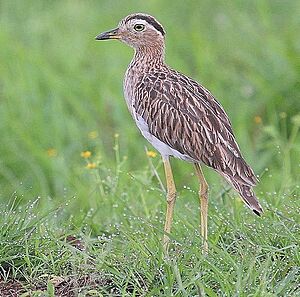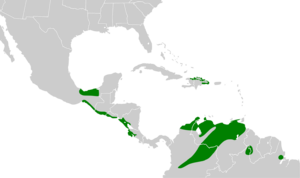Double-striped thick-knee facts for kids
Quick facts for kids Double-striped thick-knee |
|
|---|---|
 |
|
| Conservation status | |
| Scientific classification | |
| Genus: |
Hesperoburhinus
|
| Species: |
bistriatus
|
 |
|
| range (year-round resident) | |
The double-striped thick-knee (Hesperoburhinus bistriatus) is a fascinating bird. It belongs to a group called stone-curlews. These birds are a type of wader, meaning they often have long legs and live near water. The name "thick-knee" comes from the noticeable joints on its long, greenish-grey legs. The "double-striped" part refers to the two stripes you can see on its head.
Contents
About the Double-striped Thick-knee's Name
The double-striped thick-knee was first officially described in 1829. A German scientist named Johann Georg Wagler gave it the scientific name Charadrius bistriatus. The name bistriatus is Latin. It means "two-striped" or "double-striped," which perfectly describes the bird's head pattern.
This bird is now part of a newer group of birds called Hesperoburhinus. Scientists sometimes move animals into new groups as they learn more about them.
Different Types of Double-striped Thick-knees
There are four main types, or subspecies, of the double-striped thick-knee:
- H. b. bistriatus: Found from southern Mexico to northwest Costa Rica.
- H. b. vocifer: Lives in Venezuela, Guyana, and northern Brazil.
- H. b. pediacus: Found in northern Colombia.
- H. b. dominicensis: Lives on the island of Hispaniola (which includes the Dominican Republic and Haiti).
What Does a Double-striped Thick-knee Look Like?
This bird is a medium-sized wader. It has a strong bill that is black and yellow. Its large yellow eyes can make it look a bit like a reptile! Its feathers help it blend in with its surroundings.
An adult bird is about 46 to 50 centimeters (18 to 20 inches) long. It weighs around 780 to 785 grams (27.5 to 27.7 ounces). Its upper body is grey-brown with fine streaks. Its neck and chest are a lighter brown, blending into a white belly. A clear white stripe runs above its eye, with a black stripe just above that.
Young birds look a lot like adults. However, their upper parts are a bit darker brown, and their neck is whitish. When the double-striped thick-knee flies, it looks very striking. It has a white patch on its dark upper wing and a white underwing with a black edge at the back.
The four different types of these birds vary slightly in size and feather color. But it can be hard to tell them apart just by looking at them.
Where Do Double-striped Thick-knees Live?
These birds live in Central America and South America. You can find them from southern Mexico all the way down to Colombia, Venezuela, and northern Brazil. They also live on the island of Hispaniola and some islands near Venezuela in the Caribbean.
They love dry, open places. You'll often find them in grasslands, savannas, and other dry, open areas. Sometimes, a few birds might wander to places like Trinidad, Curaçao, or even the United States.
How Do Double-striped Thick-knees Behave?
The double-striped thick-knee is mostly active at night or during twilight hours (dawn and dusk). This means it is a nocturnal and crepuscular species. It doesn't like to fly unless it has to. Instead, it prefers to crouch down and use its camouflage to hide from danger.
What Do They Eat?
These birds eat large insects. They also hunt other small animals without backbones (invertebrates) and small animals with backbones (vertebrates). Sometimes, people even let these birds live near their homes. This is because the birds are helpful in controlling insects. They have also benefited from forests being cleared to create open pastures, which is their preferred habitat.
Their Song
At night, you can hear their loud song. It sounds like kee-kee-kee.
How Do They Have Babies?
When it's time to lay eggs, the double-striped thick-knee makes a simple nest. It's just a bare scrape on the ground. The female lays two olive-brown eggs. Both parents take turns sitting on the eggs to keep them warm. This incubation period lasts for about 25 to 27 days.
When the chicks hatch, they are covered in soft downy feathers. They are also precocial, which means they are quite developed and can leave the nest very soon after hatching.
Images for kids





